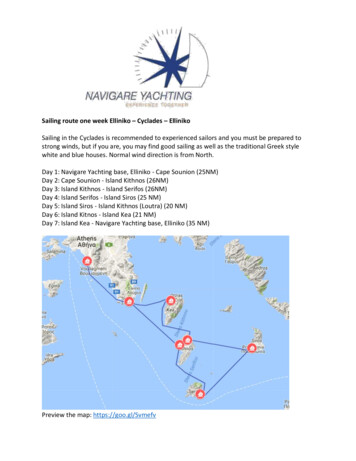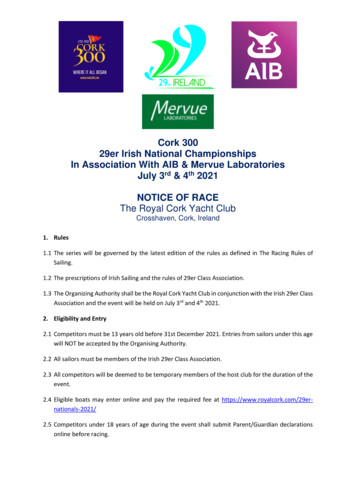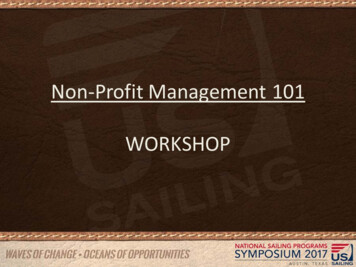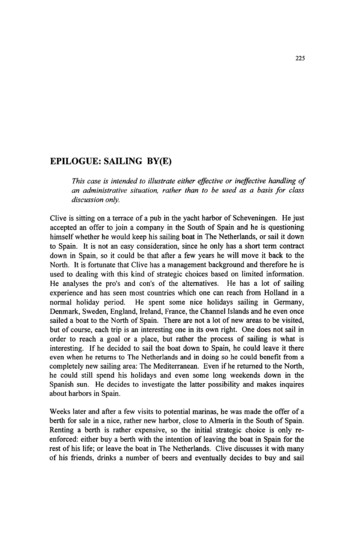
Transcription
225EPILOGUE: SAILING BY(E)This case is intended to illustrate either effective or ineffective handling ofan administrative situation, rather than to be used as a basis for classdiscussion only.Clive is sitting on a terrace of a pub in the yacht harbor of Scheveningen. He justaccepted an offer to join a company in the South of Spain and he is questioninghimself whether he would keep his sailing boat in The Netherlands, or sail it downto Spain. It is not an easy consideration, since he only has a short term contractdown in Spain, so it could be that after a few years he will move it back to theNorth. It is fortunate that Clive has a management background and therefore he isused to dealing with this kind of strategic choices based on limited information.He analyses the pro's and con's of the alternatives. He has a lot of sailingexperience and has seen most countries which one can reach from Holland in anormal holiday period. He spent some nice holidays sailing in Germany,Denmark, Sweden, England, Ireland, France, the Channel Islands and he even oncesailed a boat to the North of Spain. There are not a lot of new areas to be visited,but of course, each trip is an interesting one in its own right. One does not sail inorder to reach a goal or a place, but rather the process of sailing is what isinteresting. If he decided to sail the boat down to Spain, he could leave it thereeven when he returns to The Netherlands and in doing so he could benefit from acompletely new sailing area: The Mediterranean. Even if he returned to the North,he could still spend his holidays and even some long weekends down in theSpanish sun. He decides to investigate the latter possibility and makes inquiresabout harbors in Spain.Weeks later and after a few visits to potential marinas, he was made the offer of aberth for sale in a nice, rather new harbor, close to Almeria in the South of Spain.Renting a berth is rather expensive, so the initial strategic choice is only reenforced: either buy a berth with the intention of leaving the boat in Spain for therest of his life; or leave the boat in The Netherlands. Clive discusses it with manyof his friends, drinks a number of beers and eventually decides to buy and sail
226EPILOGUE: SAILING BY(E)South. Only the future will tell whether this was the correct decision, if indeed acorrect decision exists.Since Clive is an experienced sailor, he knows he has to prepare this trip verythoroughly. He starts reading books about the possible ways to go, based on theexperience of other people who have already convoyed boats to the Mediterranean.Clive knows a lot of people who are interested in accompanying him. After quite awhile of assessing all the alternatives he decides to go via the Channel and theSouth of England until Falmouth. From there he would cross the Bay of Biscay toLa Corufia (the North of Spain), continue along the coast of Portugal, passGibraltar and into the Mediterranean. As a crew he finds a couple with impressiveexperience. Paul is a professional with the merchant navy and his friend Mary hasbeen sailing for years on different yachts. Her experience even includes atransatlantic crossing. Clive knows them well and he feels comfortable with thiscrew. The trip is planned and they schedule four weeks of holiday for it. It isestimated that 14 sailing days are necessary, hence another 14 days are either asafety margin if things go wrong, or it provides some time to visit interestingplaces.Preparation takes place. Sea charts and pilot books are bought for the entire route.Food and drinks are stored. Insurance is expanded to cover this trip. The weekendbefore, Mary and Paul are coming down to help him load the boat as Clive plans toleave of the Monday. Needless to say the Saturday was one of these exceptionallybeautiful days and hence it all starts in the pub of the sailing club with a morningcoffee.When Mary leaves the pub, she does not see a little step and falls. She seems tohurt herself seriously. She cannot get up and they decide to take her to hospitalimmediately. There they identify broken ligaments. Normally she should get aplaster and that means that she cannot go for the trip. This is not only a personaldrama for her, but of course also a little problem for Clive. Fortunately, the doctoron duty is a sailor himself. After some discussion about the big plans ahead heagrees to give her a flexible plaster which she can put on and take off when shewants. However, he warns her that she should not take it off and that even with theplaster, it is stupidity to think about crossing the Bay of Biscay. If they had badweather, she would not be able to be an active member of the crew. And why else
ORGANIZATIONAL LEARNING AND KNOWLEDGE TECHNOLOGIESIN A DYNAMIC ENVIRONMENT227does one participate in a crossing like this one, if not to be an active member of thecrew?Needless to say that the atmosphere was not really very cheerful. What could bedone? A number of alternatives were considered like delaying the start date,finding another crew member, or changing the itinerary. Eventually, Clive inagreement with his crew, decided on the last option. They would follow theFrench coast of the Channel, which would allow them to enter a harbor in case theweather changed. Past Brest they would head for Bordeaux in order to go via the"Canal du Midi". This is a canal which crosses France and brings the boat viamore than 100 locks to the Mediterranean. The mast has to be taken off to crossthe canal which would cause some problems. Clive had a radar installed justbefore this trip. He had asked the radar cable to be installed in one piece withoutconnectors on the deck, since he judged that it was better for the quality ofreception and he would never take his mast off anyway. As a famous Dutch writerwrote: "Things can change", can't they?The plan was then, once they were in the Mediterranean, they still had to reachAlmeria. In case this was impossible, they could then leave the yacht anywhere atany Spanish harbor and Clive could sail it further down at weekends. Some joy reappeared on their faces and eventually on Monday they left Scheveningen with alight north-westerly wind.As usual with such kind of distance trips, the very start is a mixture of joy andanticipation for what is ahead, but equally the crew had to get used to the seaagain. Most people struggle a little with an initial feeling of unease, which oftendisappears after a few hours. In front of the Belgian coast the wind shifts and turnsto the south-west, which is, needless to say, the course of the yacht. The engine isstarted and sailing against the wind using the engine again proves to be ratheruncomfortable. When a few hours later the current also turns against them, sailingbecomes increasingly uneasy. Suddenly Mary observes water in the galley. Thecrew starts looking for possible holes or malfunctioning of the engine, but they donot find anything at first sight. Further research leads to a "useless" extension onthe engine, which is installed in one of the coffers, with the aim, if ever desired, toconnect a warm water system. It should be maintained with the annual enginemaintenance, which Clive pays a Volvo-dealer for each year. However, this
228EPILOGUE: SAILING BY(E)particular (hidden) part of the engine seems never to be maintained. Water poursout and no other solution is found than to enter the Calais harbor for repair.That same evening nobody can be found to repair the engine. The day after itappears that the nearest dealer is in Gravelines (20 kIn away from Calais) and theyhave to come especially for Clive. Not only does it take some time, but it alsocauses an additional cost. Clive feels a little sour about it, since he pays formaintenance each year and he will have to pay yet another amount for themaintenance not done. The time to wait for the repair people and the repair to bedone, takes the entire day. Calais harbor only opens its locks twice a day, so theywill not be ready in time to leave that day.As one expects from an experienced crew, they regularly check the weatherforecast. The entire day a south-westerly storm is announced. Since this preoccupies the crew, they go and find more detailed information about theexpectations for the rest of the week. This south-westerly storm is expected to lastat least 5 or 6 days. There is no way of going against it in order to reach Brest.What can be done?Calais is used by a lot of British sailors as a starting point for a trip to theMediterranean via the canals of France. They take off their mast in Calais and ittakes them between 3 and 4 weeks to reach a place close to Marseille. It is an easyway to get to the South for those who do not want to use the Ocean. Clive alwaysfelt that sailing boats should sail and not be used as power boats. But of course, itremains an alternative. It dramatically changes the entire idea of the trip and itnecessitates other charts and pilot books. Furthermore, the boat has to be preparedfor that and they have no material with them to do so. Other alternatives areconsidered. They can wait and see whether the storm remains for the entire week.In that case and if the storm continues, they may not have time to get to Canal duMidi. If anything would happen, they would have to leave the boat somewhere onthe Atlantic coast, and sailing it further from there would be a major problem (timewise as well as technically) for Clive. Another solution might be to try and sailout, cross to the South of England and see how far they get. If they feel it is notgoing to work, then they could still return to Holland and put the boat on a truck.Again Clive feels that sailing boats are not made to be transported by trucks, butthe trip had started and he feels he should make the best out of it. They inquire
ORGANIZATIONAL LEARNING AND KNOWLEDGE TECHNOLOGIESIN A DYNAMIC ENVIRONMENT229about the price of road transportation, which brings this alternative slightly out ofreach.The discussion which takes place is more animated than the previous one inScheveningen. Everybody in the harbor is willing to give good advice, but thatdoes not make it any clearer which is the best decision, if indeed a good decisionexists. Eventually Clive opts for the lowest risk. He takes off the mast, which hefeels very bad about. Then he plans to go via the canals of France in the hope thathe can do it in less than three weeks. He would have some more time to get theboat at least to Barcelona. From there, he can sail the boat further South with hiswife Jana or single-handed. He is sure he will not be able to get any further thanBarcelona, but he is equally sure he will get there. All other alternatives could takehim further, but equally they might not. Clive is not proud of his decision andfeels particularly bad when the mast is taken off. He feels it as if his boat has hadan amputation. He needs another few days to overcome that decision mentally.With a very friendly and helpful person at the local wharf, a solution is found toprepare the boat for its trip through the canals. A new adventure awaits them, butthe anticipation is much less.When the mast is taken off, it is observed that a part of the mast is broken. Thiscould not be detected while the mast was standing and it could have caused majorproblems. If they had sailed via the Ocean and the weather had turned bad, it isnot certain that the mast would have stayed, it would probably have broken. Thiscan cause major problems of a kind which no sailor really looks forward to. Onecan call it good news with the bad news, though the good news remains bad newstoo. A new piece has to be ordered. The wharf which constructed the boat (inBelgium) is contacted and they seem able to order a new piece in Sweden (wherethe mast originates). How different the world would look these days if one had noGSM phone system! The wharf agrees to mail the new piece straight to Jana, sothat she can take it with her when she comes down to visit the crew around thetime they are expected to be in Marseille. The crew needs the piece in order to putthe mast up again. It looks a little like a Just-in-Time operation between differentparties, of which some are mobile and no fixed time schedule is available.Fortunately, Clive has dealt with these theories in one of his previous jobs.The crew considers this broken piece as a sign from heaven that they took the rightoption. Not that it really helps to raise the moral, but if one considers it
230EPILOGUE: SAILING BY(E)objectively, this damage could have caused really serious problems. Thinkingabout all this, Clive steers his boat through the frrst of the 210 locks they arefacing. He has to pay tolls for the use of the canals and while doing so hequestions how many days he should calculate for the trip. The clerk estimates it totake 3 weeks easily. Clive panics a little, since that would imply that they mightprobably not even reach Barcelona. Therefore he decides that each day they startsailing at 6.30 am, when the locks start operating and they sail each day till 8.30p.m., the time when the locks close down.A routine is established on board. None of the crew members had sailed on canalsbefore and they do not even know the rules and regulations. In Calais they buy anumber of new charts and pilot books, as well as a book about the navigationalrules on canals. The charts and pilot books look completely different from whatthey are used to, but after a few days they feel at ease with them. In the beginningthe locks cause tension on board, since the crew has no previous experience, butafter a few days even the locks become routine. Everything is new for them andthey learn fast via trial and error. Fortunately, this does not cause a lot of damageto the boat.Though France makes a lot of publicity about trips along their canals, Clive, Pauland Mary are not impressed by the accommodation. There are no harbors andthere are hardly any places to moor. If a place is indicated on the chart, it is eithernot there, or it is used by commercial boats. Sometimes they have to moor along agrass digue. Sometimes they have to "park" alongside a commercial vessel. Thedepth of the canals is not always as indicated on the charts, especially when goingaway from the center. 1200 kilometers later, passing the 210 locks and 5 tunnels(of which some are a few kilometers long and have no lighting), they eventuallyarrive close to Marseille.During the last days of the trip, contact is made with Jana in order to coordinateher trip to deliver the new piece of the mast. She will arrive at Marseille airportand she should be picked up by car. There is no way to reach the harbor wherethey are: no busses, no trains, no nothing. Needless to say that each of these littletiny problems take lots of time to solve. Probably that is what one should expectwhen managing projects of this kind.
ORGANIZATIONAL LEARNING AND KNOWLEDGE TECHNOLOGIESIN A DYNAMIC ENVIRONMENT231The mast is set up again on a wharf and it does not take them too long: they areexperienced. The problem is then to reconnect all the electricity, specially theradar cable. The crew is very happy to see that the radar is operating again. Onealways seems to feel sorry if something new does not operate, certainly if onecauses the defect oneself. After a full day of work, the boat is ready to sail again.Clive feels extremely happy. They succeeded getting through the canals in arecord time of 2 weeks. It was rather awful and it resembled more a slave journeythan a holiday. But he is happy that he is eventually in the Mediterranean, themast is up again, the radar operates and Jana is there. Life looks just that little bitbrighter.The crew decides that for the last week of the period scheduled, they deserve someholidays. Instead of trying to reach a place past Barcelona, it is decided to sailonly during day time and try and enjoy the last part of the trip a little. Tension onboard had risen considerably over the three weeks and that also needed someattention.Except for some of the ongoing small problems which can suddenly seemimportant, Clive, Paul and Mary reached Barcelona without major mishapshappening. They have to leave the boat there and rent a car to drive to the Southof Spain, since, they had booked plane tickets back to Holland from Almeria. Ittakes them a full day of driving in very hot weather, but at last they reach Almeria,though not by boat. But in general, they feel that they have achieved at least partof the goal.The rest of the trip from Barcelona to Almeria will be sailed by Clive and Jana,using some (long) weekends, operating from their new home base in the South ofSpain. Since berthing in Spain is expensive, they are planning how to sail, as fastas possible, down to the South. Two weeks later they fly back to Barcelona fortheir first trip. Since Jana is not that experienced, it is decided to sail only in daytime. It limits the radius, but it also makes the trips more enjoyable.Clive knows that the Mediterranean is different from the Atlantic. He had read alot about it and in earlier years he rented boats in the South of France. In summerthere is little wind but also almost no storms. However, when a storm comes up, itcomes up fast. Therefore he decides to follow the weather forecasts very closely,certainly in the beginning. Despite the announced force 2 to 3 from the north-east,
232EPILOGUE: SAILING BY(E)in the afternoon of the second day a South 5 to 6 comes up. During one of thesewind-shifts, Clive wants to take the Jib in, but the roller-jib fails to operate. Thesail is blocked and on a wobbly sea this is extremely uncomfortable. The roller-jibsystem seems to be broken close to the mast and it has destroyed a part of the sail.Clive cannot lower the sail and therefore decides to make a number of circles withthe boat in order to role in the jib in mechanically. Then he heads for the closestharbor and starts looking for a mechanic. He hardly speaks Spanish, which ofcourse does not facilitate the task. Eventually he finds a mechanic who can fix thesystem the next day, but this mechanic also warns them of a severe storm to come.Though it is summer, and the weather forecast expects a force 4 to 5, the localpeople warn him not to go out. After long consideration Clive decides to believethe locals. In the afternoon a gale force II comes over, something which hadnever happened before in the history of that part of Spain. Clive and Jana feel veryfrightened but they decide to stay on board in the harbor. Who would ever haveimagined Clive being scared on his boat in the harbor? In the meantime two moredays are lost. Clive and Jana need to return and they have to leave the boat in theharbor again.They plan to come down a week later and take another week off to progress a littlemore. When they arrive on board, to their great surprise, they have rats on board!Clive was not aware at all that this could happen on a modem sailing yacht. Therats had gone mad. They had bitten into all the milk cartons so milk waseverywhere. They did the same with the orange juice. The smell is unbearable.Furthermore they have appreciated the biscuits, the chocolate, etc. But they alsohave eaten some of the sleeping bags and even some of the clothes. More out ofanger than with the aim of doing something intelligent, Clive starts looking for therats. After a long while he finds one and is very happy to be able to get itoverboard. He completely ignores that rats can swim and never live on their ownand during his first night on board again, he hears the brothers and sisters runningthrough the boat. The next day he buys poison and puts it in different places in theboat. Sometimes, problems need immediate action of a disastrous nature.Sometimes the "enemy" needs to be attacked head on.The week goes well. Each day the weather forecast gives a gentle 2 or 3 out of anortherly direction (which is interesting going South) and each day they get a 4 or5 out of the South. After all, Clive and Jana start thinking that the world isprobably organized in a post-modem way, and this is may be the first real proof of
ORGANIZATIONAL LEARNING AND KNOWLEDGE TECHNOLOGIESIN A DYNAMIC ENVIRONMENT233this. At least this experience teaches them to ignore the weather forecast for therest of their trip. The roller jib breaks down again and it appears impossible to getit repaired in the next harbor. Where the fIrst time this happened they were veryconcerned, this time they are used to it and they just continue their voyage.Eventually, three harbors further on, they fmd somebody who can repair it. At theend of that week they have to leave the boat again in another harbor, but the fInalgoal is nearer. They would only need two more weekends to get to Almeria.The fIrst weekend goes well. It appears that no further rat activities took place intheir absence. The weather forecasts remain equally bad. The best news is thatthey arrive at the end of the weekend in a harbor where no harbor duties are due.It is so exceptional that they wonder whether they should leave the boat there.They suddenly get the strange feeling that if you pay harbor duties, your boat is"protected" against e.g. theft and if you do not pay, it is not protected. Theycannot rationalize that feeling, but nevertheless it exists. Services for which onedoes not pay are no services, are they? On the other hand paying for a specifIcservice gives it a status, independent of its quality. However, after longconsideration they decide to leave the boat there "unattended". It did help as theydid not really have an alternative.One week later they go back for what should be their last weekend of sailing theirboat down. They only need three more days and they sail along one of the nicestcoast-lines of Spain, i.e. the province of Murcia. There are very few harbors inthat part of Spain and you have to make sure not to miss them. Of course, in manycases, they are overcrowded. The first night they can get a place at the very end ofa pontoon. It is not really a place, but if it brings in some additional money, whyshould the harbor not be creative? The second night there is no place in theharbor at all and they decide to anchor. Their last night should be a romantic one,anchored in a nice bay.What a mistake they made. That very night is the night of the local fIesta. Loudmusic until 6 in the morning, together with fIreworks at around 3am. It seems thatthey are in the middle of one of these old pirate movies and they feel as if they arethe target of the shooting. Nothing is less true, but imagination can do quite a lot.Around 5 in the morning, Clive suddenly hears a few people swimming around theboat, discussing how to get in the boat. He jumps out of his bed and most
234EPILOGUE: SAILING BY(E)probably due to his bad night he shouts louder than necessary that if they do notdisappear immediately, he will do "God knows what". It works.Tired but happy they arrive in the morning of the next day in Almeria. They moorat the berth which they bought months before. They leave the boat and they have apleasant drink in one of the many bars around the harbor. At last they havearrived.They have arrived at the place they intended to be months ago. The strategy whichClive had decided on was still valid. He had to admit that the way he achieved itdramatically differs from the way he planned. Fortunately he kept the ultimategoal in mind each time he encountered another problem. Clearly, he changed histactics often and sometimes very drastically. He bought lots of sea charts and pilotbooks which are still brand new and not even touched. He bought a number ofnew charts and books along the way. He arrived almost two months later thanforeseen and the trip had cost him probably around 30 % more than he originallybudgeted for. He lived through a completely different experience, not necessarilybetter or worse than the planned one, only different.While drinking his sangria on yet another terrace of another bar in another marina,now in the sun, he felt he had achieved what should have been achieved.However, he also kept in mind that this particular day was only the very fIrst dayof the rest of his sailing life.Assignment questions1. How much of this case do you recognize in any management case of your ownexperience? Identify those specific parts of this case which are comparable toyour own corporate experience (case). Highlight them.2. Can you draw some general observations out of these highlighted parts of thetext? How do these general observations coincide with those identified inchapter 8.
ORGANIZATIONAL LEARNING AND KNOWLEDGE TECHNOLOGIESIN A DYNAMIC ENVIRONMENT2353. Can you identify the moments in this case where Clive applied in one way oranother some of the concepts dealt with in this book ?4.Discuss the methods and attitudes which could have helped Clive in hisdecision making process at each of the different moments you identified in theprevious question. Do not apply this discussion to Clive's case, but rather toyour own corporate case.5. What can you learn from this case with respect to your own management style?6. Take any management case you are familiar with and try to structure it into acase/story, either related to sailing, or to a music performance (depending onwhich of the two you are more familiar with). Does this shed new light onyour managerial case? Is it easier to discuss this sailing/music case than todiscuss the management case? Discuss.7. Why do we have that feeling that the discussion of this sailing/music case is lessserious and that we would learn less from it than from using "real" managementcases? What does this tell us about our perception of management? Discuss.
237ANNEX : AN EPISTEMOLOGICAL VOYAGE THROUGHCONNECTIONISM AND POSITIVISM (CO-AUTHORED BYGERT VAN DER LINDEN)Along with growing activity in the field of IS research, IS research methodology initself is developing into an independent subject of enquiry (Mumford et aI., 1985;Cash and Lawrence, 1989; Benbasat, 1990; Nissen et aI., 1990; Kraemer, 1991;Galliers, 1991b; Galliers, 1992). It seems relevant, at this point, to discussdifferent approaches and methodologies and explain what their underlyingassumptions are. It is also important for the practitioner to get a .really "closereading" of what to expect from research, both the more traditional IS researchapproaches, as well as the perspective this book offers: neural networks andconnectionist approaches. It shows how selecting a particular methodology impliesa fundamental position or epistemology.We also attempt to outline how methodology is related to the aims of science.Indeed, as Bachelard (in Merquior, 1988) stresses, a research proposal and ahypothesis are developed within the framework of an evolving scientificenvironment and never in an intellectual and cognitive vacuum. Sartre (in Daudi,1986) points out that a research method is a philosophical question via whichresearch expresses itself.Indeed, science is greater than the object that it studies. It is a voyage ofdiscovery. It is trial and error, guessing and arguing. Hence, science can beconsidered as a "verb". Given the particular relationship that the researcher - theexplorer - has with his object, science can be seen as a dialogue. "Science" is areflection of a relationship with existing praxis. It is working with language andworking with the self.It is this dialogue, or reflection, which is of special interest to the practitionerwishing to gain greater insight into the philosophy behind IS research projects. It isalso relevant to those, practitioners and scholars alike, who are interested in how aresearch project is designed and how it comes about, how the outcome of a
238ANNeX: AN ePiSTeMOLOGICAL VOYAGETHROUGH CONNECTIONISM AND POSITIVISMparticular research project is related to the foundations on which a particularmethodology is based, its epistemology. Please note that some paragraphs areaimed at scholars rather than at more practically-minded readers.A.I. Science and scientific actionTraditionally, research methods, including IS research methods, are categorizedinto two groups: scientific and interpretive. Scientific approaches may be definedas those that arise from the positivist tradition, characterized by repeatability,reductionism and refutability (Checkland, 1981). It assumes that observations canbe made objectively and rigorously (Klein and Lyytinen, 1985). In terms ofquestioning perceptions (as is often the case in management research), it isarguable whether objective measuring is possible at all.In juxtaposition to the scientific method, interpretive approaches argue that thescientific ethos is misplaced in terms of scientific inquiry because it fails toaccount for the numerous possible ways of interpreting the same phenomena, thepersonal impact the scientist has as an individual crafting a research project, aswell as problems associated with forecasting future events concerned with humanactivity (Galliers, 1985a, after Checkland, 1981). According to positivists, aqualitative approach to research also has a number of limitations (Bryman, 1988).Firstly, the researcher does not have the ability to see through other people's eyesand thus interpret events from their point of view; secondly, there needs to be astrong relationship between theory and research, and lastly, there is the extent towhich qualitative research deriving from case studies can be generalized.Recent research practice suggests that the dual opposing categorization does notreally reflect developments which have taken place in science, in the field of IS,and in the area of knowledge management in particular. The duality is principallystill rooted in the classical view of science, in notions of "truth" being shaped anddefined by scientific methods.According to Popper (1963), the "philosophical father" of positivism, scienceapproaches truth by identifying and elim
Food and drinks are stored. Insurance is expanded to cover this trip. The weekend before, Mary and Paul are coming down to help him load the boat as Clive plans to leave of the Monday. Needless to say the Saturday was one of these exceptionally beautiful days and hence it all starts in the pub of the sailing club with a morning coffee.
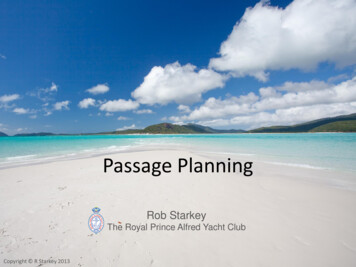
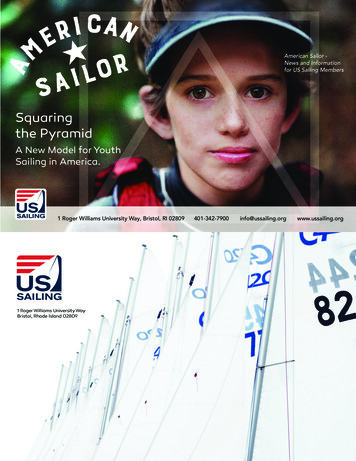
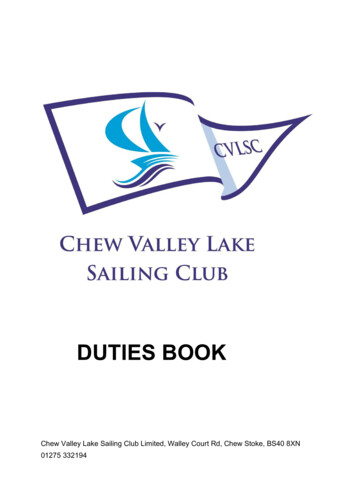
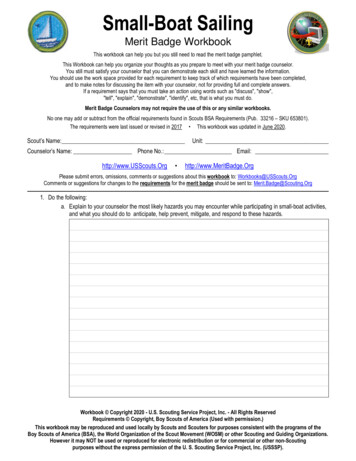
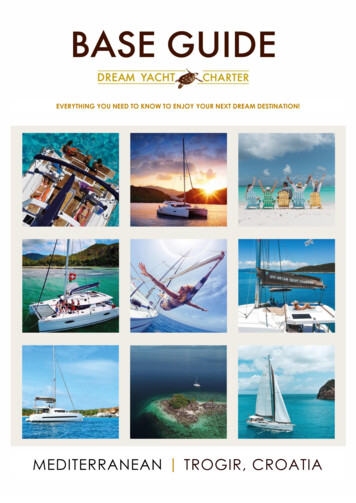
![Teach Sailing the Fun Way Activity Guide Draft[1]](/img/28/teach-sailing-the-fun-way-activity-guide-draft1.jpg)

